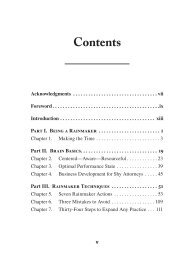(Bk Business) Carol Kinsey Goman Ph.D.-The Nonverbal Advantage_ Secrets and Science of Body Language at Work -Berrett-Koehler Publishers (2008)
Just
Just
You also want an ePaper? Increase the reach of your titles
YUMPU automatically turns print PDFs into web optimized ePapers that Google loves.
Chapter 2: Reading the Whole <strong>Body</strong><br />
37<br />
We all do it. Babies do it even before birth, where their<br />
heartbe<strong>at</strong>s <strong>and</strong> bodily functions have a rhythm th<strong>at</strong> m<strong>at</strong>ches<br />
those <strong>of</strong> their mothers. As adults we do it when we are talking<br />
with someone we like or are interested in. We subconsciously<br />
switch our body posture to m<strong>at</strong>ch th<strong>at</strong> <strong>of</strong> the other person—<br />
mirroring th<strong>at</strong> person’s nonverbal behavior <strong>and</strong> signaling<br />
th<strong>at</strong> we are connected <strong>and</strong> engaged.<br />
When a colleague mirrors your body language, it’s his<br />
way <strong>of</strong> nonverbally saying th<strong>at</strong> he likes or agrees with you.<br />
And if you are one <strong>of</strong> two equal-st<strong>at</strong>us executives in a discussion,<br />
you may both, unknowingly, be adopting similar postures<br />
to maintain your respective positions <strong>of</strong> authority.<br />
When done with intent, mirroring can be an important<br />
part <strong>of</strong> developing business rel<strong>at</strong>ionships. Whether you are<br />
a team leader, a teacher, or a therapist, an effective way to<br />
build rapport (or to increase a person’s comfort when he or<br />
she is resistant) is to utilize this technique. Mirroring starts<br />
by observing a person’s body posture <strong>and</strong> then subtly letting<br />
your body reflect his position. If his arms are crossed, slowly<br />
begin to cross your arms. If he leans back, you do the same.<br />
In my work as a therapist, I would even mimic a client’s<br />
bre<strong>at</strong>hing p<strong>at</strong>tern—inhaling <strong>and</strong> exhaling in sync with his<br />
or her rhythm.<br />
It’s a proven method. A recent research study observed<br />
two different teachers as they taught students. One used<br />
mirroring; the other did not. <strong>The</strong> students’ reactions were<br />
substantially more positive toward the teacher who used mirroring<br />
techniques. <strong>The</strong>y believed th<strong>at</strong> th<strong>at</strong> teacher was much<br />
more successful, friendly, <strong>and</strong> appealing.<br />
When a person is closed <strong>of</strong>f or resistant, the easiest way<br />
to increase her comfort level is to use mirroring. This technique<br />
is useful with clients, sales prospects, customers, <strong>and</strong><br />
co-workers. It is a silent signal th<strong>at</strong> you are positively rel<strong>at</strong>ing<br />
to the other person. But before you try it out on the boss, you<br />
can practice on strangers.




